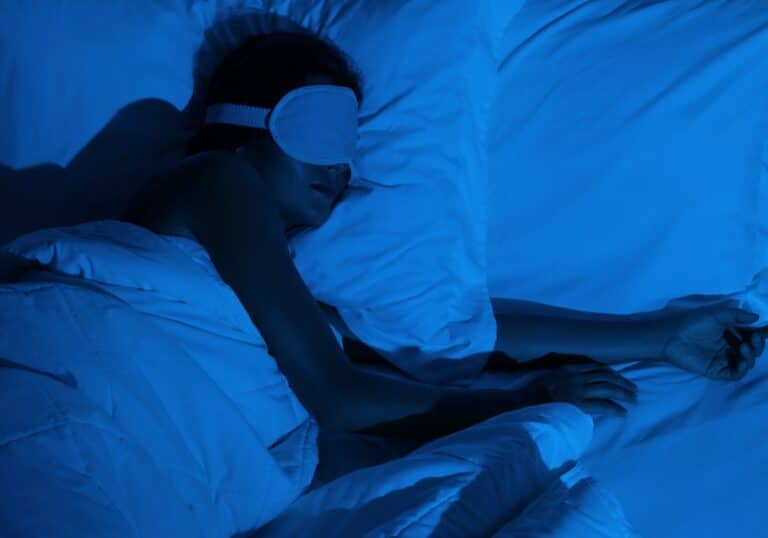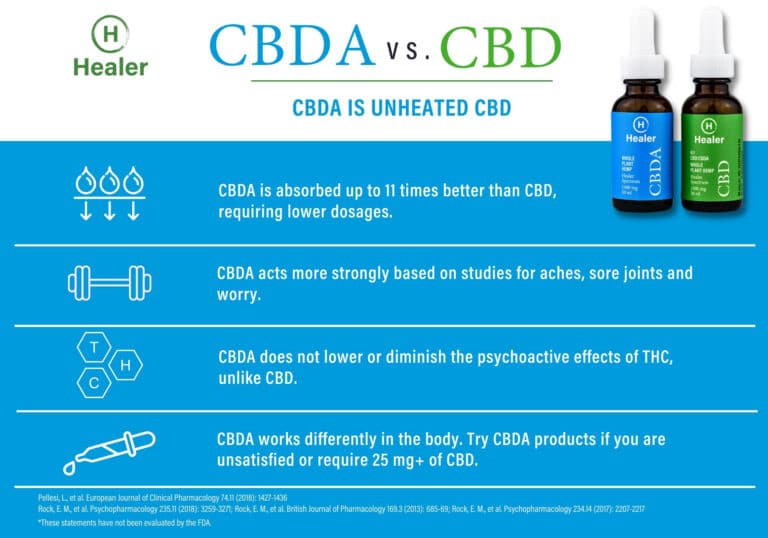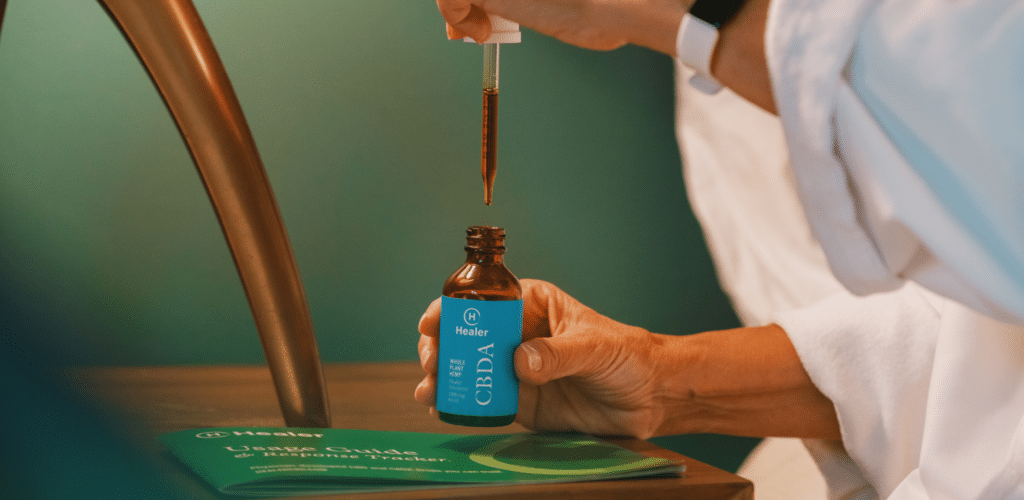
Most people are familiar with CBD oil, which is very popular these days for its health and wellness benefits. But there’s another lesser known cannabinoid called CBDA that is gaining attention from consumers and the scientific community as early findings show that even small amounts of CBDA can have significant beneficial physiological effects.
CBDA has many important differences to CBD that make it even more powerful, namely
- CBDA is better absorbed (5-11 times better)[1]
- CBDA acts more strongly in the body 2], pain[3], nausea[4], and worry[5].
- CBDA does not lower or diminish the benefits of THC like CBD.
Because high-quality human research on these cannabinoids is still emerging and there are still many unknowns, in this post we’ll share what you need to know about this CBDA oil.
What is a cannabinoid?
Cannabinoids are the most studied group of naturally occurring chemical compounds in cannabis and hemp, mainly due to their wide range of therapeutic effects in mammals. Cannabinoids are referred to as acidic or neutral, depending on their chemical state. Acidic cannabinoids are non-intoxicating cannabinoid compounds that come straight from the cannabis and hemp plants. Over time, through heat and pressure, acidic cannabinoids ‘neutralize’ meaning they lose their carboxylic acid functional group (a process called decarboxylation) and are referred to as neutral cannabinoids.
What are the most common cannabinoids?
THC and CBD are best known cannabinoids. These two neutral cannabinoids (You can tell that they’re neutral cannabinoids, because there’s no “A” for acid in their names.) are just two of over 100+ acidic and neutral cannabinoids in the hemp plant Cannabis sativa.
What is CBDA?
CBDA is the raw, unheated precursor of CBD. Cannabis and hemp plants naturally produce CBDA, which converts to CBD slowly at room temperature, or rapidly when exposed to high temperatures. CBDA is non-impairing, just like CBD.
How is CBDA different from CBD?
In many ways, CBDA works similarly to CBD by influencing the endocannabinoid system and other biological systems within our bodies. But, CBDA has many important differences that make it even more powerful, namely CBDA is better absorbed (5-11 times better)[1] and acts more strongly in the body regarding seizures[2], pain[3], nausea[4], and anxiety[5].
You’ll see better results at lower dosages when using CBDA products (or whole plant hemp CBD products that contain CBDA) compared to pure or nearly-pure CBD isolate. If you have tried CBD without much success, don’t assume CBDA won’t help.
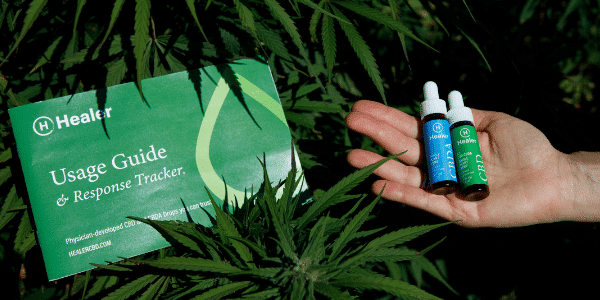
What is the most effective way to take CBDA?
Placing CBDA oil drops under your tongue (sublingual administration) is the best way to ensure fast and efficient absorption and minimize delays associated with digestion. CBDA oil drops may be added to food or drinks, too. However, you may require a larger amount and it may take longer to feel the effects. CBDA oil drops can be applied directly to the skin as a topical or added to your favorite cream or beauty product.
What is CBDA oil?
Oils infused with CBDA are the best delivery method for taking CBDA. CBDA oil is generally concentrated and used as the active ingredient in cannabis tinctures, vaporizers, topicals, capsules, edibles and other products.
High-quality CBDA oils are harder to find because acidic cannabinoids are more difficult to extract and stabilize, but those currently available come in several forms: isolate, broad spectrum, full spectrum and Healer spectrum:
- CBDA Isolates contain CBDA alone. All of the other beneficial plant components are removed using a chemical process. Since these highly processed formulas don’t absorb as well, nano-emulsifiers are added to boost their effectiveness, and the consumer typically requires higher amounts.
- Broad Spectrum CBDA products contain CBDA along with some of the naturally occurring compounds from the hemp plant, without THC or THCa. These oils are also processed using chemical reactions to remove THC and THCA.
- Full Spectrum CBDA products include the legally allowed trace amounts of THC and THCA (a maximum of 0.3% THC). While the term ‘full spectrum’ is meant to describe products that retain all of the beneficial plant compounds, many products labeled full spectrum actually only contain THC while others add in terpenes from other plants.
- Healer Spectrum CBDA products are made using Healer’s patented nano-filtration technology to contain the full range of naturally occurring plant compounds including acidic and other minor cannabinoids, the legally allowed trace amounts of THCA and THC (less than 0.3%) , and the plant’s original terpenes, flavonoids and phytonutrients.
Is there a difference between CBDA oil, CBDA tincture, CBDA drops?
CBDA oil, CBDA tincture and CBDA drops all refer to CBDA in a form that can be taken sublingually, added to food or applied directly to the skin. The word ‘tincture’ has become an all-purpose phrase to describe liquid cannabis preparations, but the true definition of tincture is an extraction in an alcohol solution.
How will CBDA oil make me feel?
When you take CBDA products, they should taste like a freshly juiced cannabis plant, producing a peppery sensation in the back of the mouth and throat. This sensation is likely the feeling of the CBDA being absorbed, as one of CBDA’s mechanisms of action is similar to capsaicin, the active constituent in hot chili peppers that activates the receptor involved in regulating pain and soreness.
If the taste is too strong for you, a sip of water will quickly remove the sensation. Or, you can also try adding CBDA drops to drinks and foods or purchase capsules. If the product you’re taking doesn’t produce that sensation, there may not be enough of this powerful cannabinoid in it.
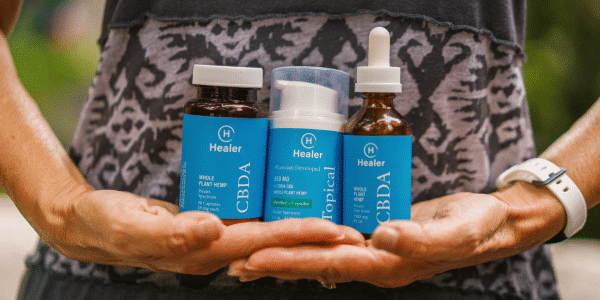
What are the benefits of taking CBDA oil?
Can CBD and CBDA truly help with symptoms related to anxiety, stress, depression, pain or sleep? Here’s what we know at this time about how CBDA can support your wellness:
CBDA:
- Promotes alertness and clear thinking
- Can help with pain and soreness
- Can improve mood, promote resilience to stress and relieve irritability
- May enhance performance and recovery from exercise
- May help with occasional sleeplessness
Is CBDA oil better than CBD oil?
Many people are now switching to CBDA oil especially if CBD oil hasn’t worked for them or they need high amounts of it 25 – 50+ mg per use. CBDA oil seems to be more anti-inflammatory and less stimulating which is better for night time use.
Adding or switching to CBDA can actually lower the amount of CBD and cannabinoids you use every day AND significantly increase the benefits.
CBDA oil also does not diminish the effects and benefits of THC products like CBD does. That’s why many people combine CBDA with THC to increase their benefits and use CBD to diminish THC’s effect if they take too much or have side effects associated with THC like grogginess, irritability, and fatigue.
Since everyone responds uniquely to CBD and CBDA, it is important to try them in the proper way to understand what one or both can do for you.
How do I take CBDA oil?
When using CBDA oils, tinctures, drops or edibles, your first goal is to find the number of milligrams (mg) of total cannabinoids (CBDA) you need to feel the benefits per each use. This may be evident quite early, or it may take up to 2 weeks or longer to discover.
The idea is to start very low (i.e., 5 mg per use), and increase your daily usage amount by 5 mg every 2 days until you start feeling results. Then, stop increasing and keep using the same number of milligrams or drops.
For many people, the amount that provides modest benefits in the first couple days will, after consistent use, provide more and more benefit over time. After you find the amount that works for you, and if you notice that the effects wear off too early in the day, this is when it’s beneficial to add more uses per day. A great resource for more detailed instructions is Healer’s Usage Guide.
Also, to increase absorption so you can take less, human studies have shown that CBD gets absorbed up to 5x better when taken with some food that contains fat or oil [6].
It’s wise to keep track of how much you take, how many times a day you take it, and your results in a journal. Be sure to rate your symptoms daily to see if they are getting better or worse.
Get Dr. Sulak’s free, clinically validated, step-by-step Usage Guide and Response Tracker© to help eliminate confusion and ensure your success with CBDA oil.
Where to buy high quality CBDA oil drops
Because the Food and Drug Administration (FDA) doesn’t regulate CBD products the same way it does drugs and supplements at this time, you must be a savvy consumer.
Whenever possible, look for locally grown, artisanal produced, and laboratory tested products. If purchasing online, it can be hard to know what retailer to trust. Hemp-based CBDA consumers should buy from companies that provide copies of an independent laboratory analysis (via a COA or certificate of analysis) that correlates with the batch in question.
See Healer’s Certificate of Analysis (COA)
What are the most important things to look for when buying CBDA oil?
CBDA and CBD products vary widely in their potency, purity, and safety. Unfortunately, several scientific studies and investigative reports have found inaccurate labeling and contamination with pesticides, heavy metals, and other toxins in at least 50% of the products tested.
Here are a few tips:
- When purchasing a CBD or CBDA product, seek out accurately labeled products providing third-party certificates of analysis that correspond to the product batch.
- Look to see how much CBDA is in 1 ml of oil. Seek products that have a high level of CBDA, i.e. 20-25 mg/ml or more versus CBDA oils that may only have 1-10 mg/ml of oil.
- Is it refrigerated? As you learned above, acidic cannabinoids neutralize over time. Refrigeration slows down the process and preserves them.
[1] Pellesi, L., et al. European Journal of Clinical Pharmacology 74.11 (2018): 1427-1436.
[2] Anderson, Lyndsey L., et al. Journal of natural products 82.11 (2019): 3047-3055.
[3] Rock, E. M., et al. Psychopharmacology 235.11 (2018): 3259-3271.
[4] Rock, E. M., et al. British Journal of Pharmacology 169.3 (2013): 685-69
[5] Rock, E. M., et al. Psychopharmacology 234.14 (2017): 2207-2217.
[6] Taylor, Lesley, et al. CNS drugs 32.11 (2018): 1053-1067.


